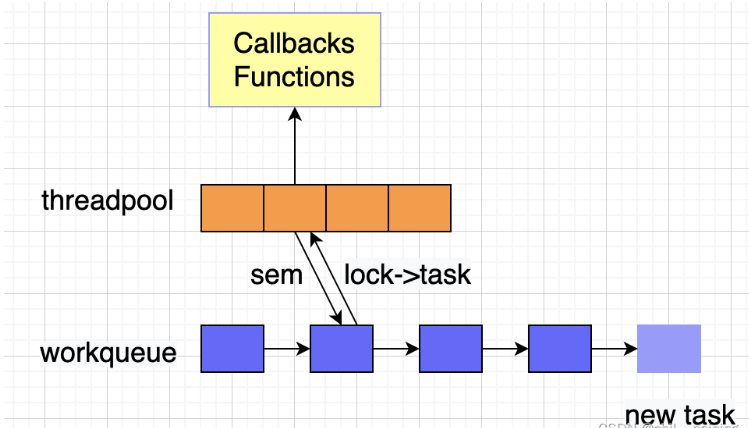溫馨提示×
您好,登錄后才能下訂單哦!
點擊 登錄注冊 即表示同意《億速云用戶服務條款》
您好,登錄后才能下訂單哦!
本文小編為大家詳細介紹“C++怎么實現一個簡單的線程池”,內容詳細,步驟清晰,細節處理妥當,希望這篇“C++怎么實現一個簡單的線程池”文章能幫助大家解決疑惑,下面跟著小編的思路慢慢深入,一起來學習新知識吧。
線程池應該包括
保存線程的容器,保存任務的容器。
為了能保證避免線程對任務的競態獲取,需要對任務隊列進行加鎖。
為了使得工作線程感知任務的到來,需要使用條件變量來喚醒工作線程。
任務容器中的任務管理。
任務的處理API。
使用數組存放線程,鏈表存放任務。

線程池類
template<typename T>
class threadpool
{
public:
threadpool(int thread_num,int max_request);
~threadpool();
bool append(T* request); // 在任務隊列中添加任務
private:
static void worker(void* arg);
void run();
private:
int m_thread_num; // 線程池中的線程數
int m_max_request; // 任務隊列最大保存的任務數
pthread_t *m_threads; // 保存線程的容器
std::list<T*>m_queuework; // 保存任務的鏈表
sem m_sem; // 通知工作線程任務到來
lock m_locker; // 互斥訪問任務隊列
};構造函數
template<typename T>
threadpool<T>::threadpool(int thread_num,int max_request):m_thread_num(thread_num),m_max_request(max_request)
{
if(thread_num <=0 || max_request <= 0) throw std::exception();
m_threads = new pthread_t[thread_num];
if(!m_threads) throw std::exception();
for(int i = 0;i < thread_num;++i)
{
// 創建線程
if(pthread_create(m_threads + i, NULL,worker,this)!=0)
{
delete[] m_threads;
throw std::exception();
}
// 分離線程
if(pthread_detach(m_threads[i]))
{
delete[] m_threads;
throw std::exception();
}
}
}析構函數
template<typename T>
threadpool<T>::~threadpool()
{
delete[] m_trheads;
}添加任務函數
template<typename T>
bool threadpool<T>::append(T* request)
{
m_locker.lock();
if(m_queuework.size() > m_max_request)
{
m_locker.unlock();
return false;
}
m_queuework.push_back(request);
m_locker.unlock();
m_sem.post();
return true;
}任務處理函數
template<typename T>
void* threadpool<T>::worker(void*arg)
{
threadpool* pool = (threadpool*)arg;
pool->run();
return pool;
}
template<typename T>
void threadpool<T>::run()
{
while(true)
{
m_sem.wait();
m_locker.lock();
if(m_queuework.empty())
{
m_locker.unlock();
continue;
}
T* request = m_queuework.front();
m_queuework.pop_front();
m_locker.unlock();
request.process(); // 具體任務的處理業務
}
}讀到這里,這篇“C++怎么實現一個簡單的線程池”文章已經介紹完畢,想要掌握這篇文章的知識點還需要大家自己動手實踐使用過才能領會,如果想了解更多相關內容的文章,歡迎關注億速云行業資訊頻道。
免責聲明:本站發布的內容(圖片、視頻和文字)以原創、轉載和分享為主,文章觀點不代表本網站立場,如果涉及侵權請聯系站長郵箱:is@yisu.com進行舉報,并提供相關證據,一經查實,將立刻刪除涉嫌侵權內容。